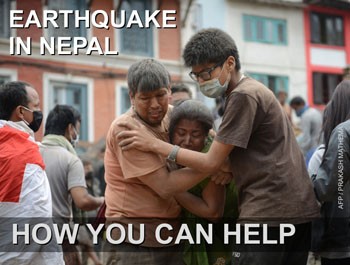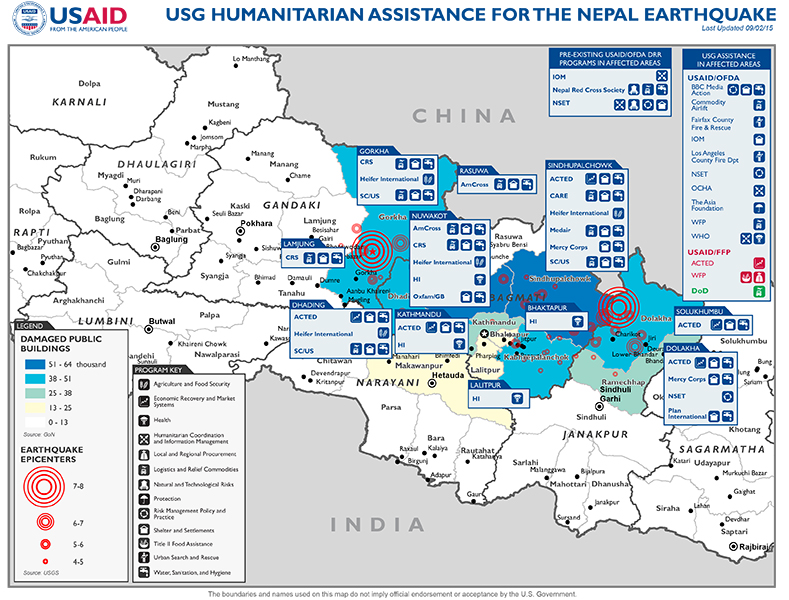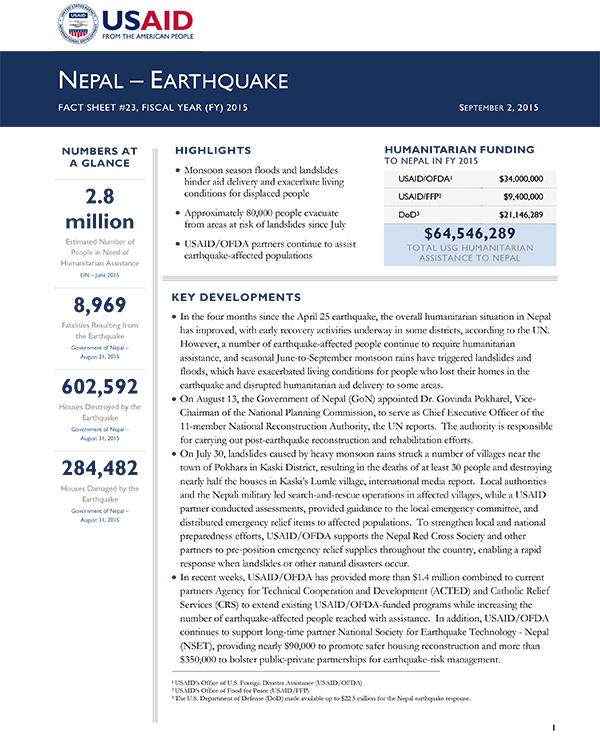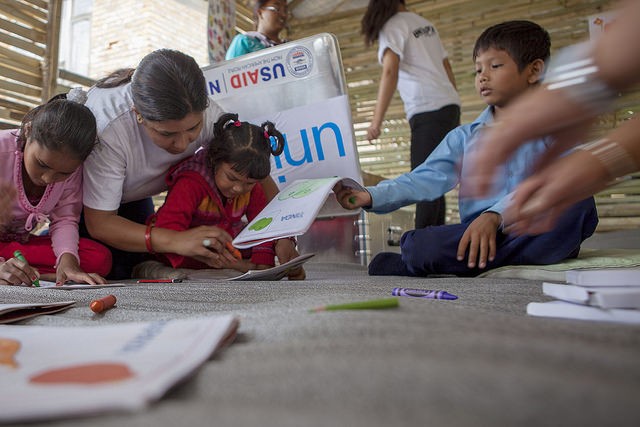September 2, 2015
Highlights
Monsoon season floods and landslides hinder aid delivery and exacerbate living conditions for displaced people
Approximately 80,000 people evacuate from areas at risk of landslides since July
USAID/OFDA partners continue to assist earthquake-affected populations
Key Developments
In the four months since the April 25 earthquake, the overall humanitarian situation in Nepal has improved, with early recovery activities underway in some districts, according to the UN. However, a number of earthquake-affected people continue to require humanitarian assistance, and seasonal June-to-September monsoon rains have triggered landslides and floods, which have exacerbated living conditions for people who lost their homes in the earthquake and disrupted humanitarian aid delivery to some areas.
Nepal Map - 09-02-2015 ![]() (pdf - 6 MB)
(pdf - 6 MB)
Numbers At A Glance
2.8 million
8,969
602,592
284,482
Humanitarian Funding:
To Nepal To Date In FY2015:
| USAID/OFDA | $34,000,000 |
| USAID/FFP | $9,400,000 |
| DoD | $21,146,289 |
| TOTAL | $64,546,289 |
Nepal Earthquake Fact Sheet #23 - 09-02-2015 ![]() (pdf - 213k)
(pdf - 213k)
On August 13, the Government of Nepal (GoN) appointed Dr. Govinda Pokharel, ViceChairman of the National Planning Commission, to serve as Chief Executive Officer of the 11-member National Reconstruction Authority, the UN reports. The authority is responsible for carrying out post-earthquake reconstruction and rehabilitation efforts.
On July 30, landslides caused by heavy monsoon rains struck a number of villages near the town of Pokhara in Kaski District, resulting in the deaths of at least 30 people and destroying nearly half the houses in Kaski’s Lumle village, international media report. Local authorities and the Nepali military led search-and-rescue operations in affected villages, while a USAID partner conducted assessments, provided guidance to the local emergency committee, and distributed emergency relief items to affected populations. To strengthen local and national preparedness efforts, USAID/OFDA supports the Nepal Red Cross Society and other partners to pre-position emergency relief supplies throughout the country, enabling a rapid response when landslides or other natural disasters occur.
In recent weeks, USAID/OFDA has provided more than $1.4 million combined to current partners Agency for Technical Cooperation and Development (ACTED) and Catholic Relief Services (CRS) to extend existing USAID/OFDA-funded programs while increasing the number of earthquake-affected people reached with assistance. In addition, USAID/OFDA continues to support long-time partner National Society for Earthquake Technology - Nepal (NSET), providing nearly $90,000 to promote safer housing reconstruction and more than $350,000 to bolster public-private partnerships for earthquake-risk management.
HUMANITARIAN ACCESS AND LOGISTICS
Physical access to populations in hard-to-reach areas of Nepal remains a concern, particularly during the monsoon season, according to the Logistics Cluster—the coordinating body for humanitarian logistical activities that comprises UN agencies, non-governmental organizations (NGOs), and other stakeholders. The increase in landslides during the monsoon season has hindered road access, leaving many earthquake-affected areas accessible only by helicopter or porters. Further, inclement weather associated with the monsoon has compelled cancellations of UN Humanitarian Air Services (UNHAS) flights and led to a decrease in the amount of cargo transported by UNHAS helicopters. In response to these events, the international humanitarian donor community plans to support the extension of UNHAS services through October.
Since the April 25 earthquake, USAID/OFDA has contributed nearly $9.8 million to partners to provide emergency relief items and enhance humanitarian logistical capacity in Nepal, thereby addressing the needs of earthquake-affected households and ensuring continued assistance during the monsoon season.
DISPLACEMENT AND SHELTER
Since the start of July, approximately 17,000 households—or an estimated 80,000 people—have evacuated from areas at increased risk of landslides during the monsoon season, the Nepal Earthquake Assessment Unit reported on August 27. The total includes nearly 6,950 households in 17 districts relocated by the GoN, as well as more than 10,000 households in Dhading, Dolakha, Gorkha, Kathmandu, and Sindhupalchowk that moved without GoN assistance. Reported relocations, with or without GoN aid, have decreased in August, according to the assessment unit.
As of mid-July, more than 59,400 people from approximately 11,000 households remained in 104 displacement sites hosting 20 or more households across Nepal, according to USAID/OFDA partner the International Organization for Migration (IOM). More than a quarter—approximately 16,000 people—were living at sites in Kathmandu District. A survey conducted by IOM revealed that approximately 60 percent of the displaced individuals residing at sites intend to depart during or immediately following the monsoon season, and 65 percent of interviewees cited housing as the key requirement for their return, underscoring the lingering need for shelter support among affected populations.
While monsoon-season response activities remain a priority, the humanitarian community in Nepal has highlighted the need to commence preparations for the onset of winter. Existing temporary shelters will likely become inadequate, and many earthquake-displaced households may be unable to rebuild residences in advance of the cold weather. Relief actors estimate that approximately 150,000 people live in areas where the average January temperature is 41°F or lower.
To date, USAID/OFDA has provided more than $8 million to support shelter interventions across earthquake-affected districts of Nepal. Most recently, USAID/OFDA provided NSET nearly $90,000 to promote safer housing reconstruction in Dolakha District through community trainings and awareness-raising sessions for approximately 190,000 people. USAID/OFDA is also providing NSET more than $350,000 to enhance public-private partnerships for earthquake-risk management and increase community awareness of and demand for disaster risk reduction (DRR) activities countrywide.
HEALTH AND WASH
According to the Health Cluster, nearly all the health facilities damaged by the April 25 and subsequent earthquakes had resumed services as of early August, although some health care services were unavailable due to monsoon-related inaccessibility. Some health facilities had vacant posts prior to the earthquake, and personnel constraints remain a concern. Members of the Health Cluster and the GoN Ministry of Health and Population are working to map existing health services and personnel resources.
The Water, Sanitation, and Hygiene (WASH) Cluster, in collaboration with the GoN, has provided emergency repairs to earthquake-damaged water systems, restoring sustained water access for approximately 435,000 people, according to the UN. The WASH Cluster has also provided approximately 2 million people with emergency water assistance, including the distribution of water containers and treatment products, since the earthquake.
To date, USAID/OFDA has provided more than $3.1 million to address the WASH needs of earthquake-affected populations in Nepal. USAID/OFDA has also contributed nearly $1 million for health interventions; part of the funding is supporting the UN World Health Organization (WHO) to establish disease surveillance systems in earthquake-affected areas to detect disease outbreaks during the monsoon season and subsequent months.
FOOD SECURITY
As of August 24, an estimated 1.4 million people across 11 districts of Nepal continued to require food assistance to meet daily dietary requirements, according to the UN. The Nepal Earthquake Assessment Unit reports that recent assessments from July conducted among earthquake-affected communities, including those in Dolakha, Gorkha, and Sindhupalchowk districts, indicate increased household indebtedness following the earthquake as a result of reductions in household incomes combined with increases in shelter expenses. Many respondents highlighted cash assistance as a primary need.
The Food Security Cluster reports distributing 241,000 kits, which include seeds, grain, animal feed, and tools, since the start of the monsoon season to support agricultural activities. According to the cluster, the harvests for maize and rice, due to begin in August and September, respectively, will be indicative for food security conditions in the coming months, and widespread damage to storage facilities may negatively affect smallholder farmers’ ability to adequately maintain their harvested crops.
In recent weeks, USAID/OFDA provided ACTED with additional funds to distribute harvest storage units to 500 households in Solukhumbu District, among other activities. The units—suitable for rice and other types of cereals, as well as potatoes—will help ensure the secure and dry storage of harvested items for vulnerable farming households, particularly those residing in areas that may not have easy access to markets during the monsoon season.
Since the April 25 earthquake, USAID/OFDA has provided approximately $1 million to support agricultural, food security, and economic recovery interventions for earthquake-affected populations. In addition, USAID/FFP has provided $6.9 million to the UN World Food Program (WFP) to support its emergency food assistance operations in Nepal, as well as $2.5 million to ACTED, which is providing short-term livelihoods support to approximately 2,250 food-insecure households in five of Nepal’s most earthquake-affected districts.
INTERNATIONAL ASSISTANCE
As of September 2, the USG had provided more than $64.5 million for earthquake response efforts in Nepal, while other international donors had provided nearly $394 million, according to the UN. The ongoing UN flash appeal is funded at approximately $230 million—54 percent of the $422 million requested.
CONTEXT
On April 25, a magnitude 7.8 earthquake struck central Nepal’s Gorkha District, approximately 77 kilometers (km) northwest of Kathmandu, at a shallow depth of approximately 15 km, according to the U.S. Geological Survey (USGS).
The USG immediately issued a disaster declaration for Nepal due to the effects of the earthquake. Within hours of the seismic event, USAID/OFDA activated a Response Management Team (RMT) in Washington, D.C., and deployed a Disaster Assistance Response Team (DART)—including urban search-and-rescue (USAR) specialists—to Nepal.
On May 12, a magnitude 7.3 aftershock struck Nepal’s Dolakha District, approximately 76 km northeast of Kathmandu, according to USGS. The aftershock caused further casualties and damage in areas affected by the April 25 earthquake.
For nearly two decades, USAID/OFDA has supported disaster risk reduction (DRR) efforts in Nepal, including throughout Kathmandu Valley. USAID/OFDA funding has enabled partners to identify, prepare, and preserve more than 80 open spaces in Kathmandu Valley for humanitarian purposes; pre-position critical emergency relief supplies; and strengthen earthquake response capacity at the local and national levels in collaboration with the GoN, nongovernmental organizations, private companies, and local communities. More information on USAID/OFDA’s DRR programs in Nepal and throughout South Asia is available at www.usaid.gov/what-we-do/working-crises-andconflict/disaster-risk-reduct....
PUBLIC DONATION INFORMATION
The most effective way people can assist relief efforts is by making cash contributions to humanitarian aid organizations that are conducting relief operations. A list of humanitarian organizations that are accepting cash donations for disaster responses around the world can be found at www.interaction.org.
USAID encourages cash donations because they allow aid professionals to procure the exact items needed (often in the affected region); reduce the burden on scarce resources (such as transportation routes, staff time, and warehouse space); can be transferred very quickly and without transportation costs; support the economy of the disaster-stricken region; and ensure culturally, dietary, and environmentally appropriate assistance.
More information can be found at:
- The Center for International Disaster Information: www.cidi.org or +1.202.821.1999.
- Information on relief activities of the humanitarian community can be found at www.reliefweb.int.











Comment
Make a general inquiry or suggest an improvement.